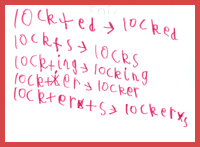
Copyright Susan and Peter Bowers 2008
WordWorks Newsletter #64 with videos and more...
Final Newsletter of 2010 - 2011 School Year
Some of the Structured Word Inquiries from Newsletter #64
The stories, videos, images, blogs and resources from this last newsletter of the year illustrate the engaging, generative experiences learners have with words and ideas when teachers are supported with resources and training that reveal how English spelling works. Here is a taste of some of what you will find
-
•Teachers teaching teachers: An amazing blog from Jen Munnerlyn, literacy coach at the American Community School of Abu Dhabi where I will visit in November. Jen brought a team to my NESA workshop. When she returned she supported her whole staff by teaching a lesson based on the Real Spelling Theme “Learning From Love” in every class from Kindergarten to Grade 5! Her video models a real learner investigating spelling with students of all ages. This video shows teachers teaching teachers about this instruction.
-
•Grade 7 humanities assessment via structured word inquiry: Long time Real Spelling expert Ann Whiting shows how studying understanding spelling structure is a tool for deepening understanding of our world. See this document with Ann’s description on the assessment including student responses using orthographic analysis to describe their learning about a humanities unit. Click here for a copy of the blank assessment tool. (NOTE: on May 11th, I fixed the first link (in bold) so that it download’s the document with student answers as intended. Previous to that date, both links downloaded blank questions of the assessment.)

-
•Grade 2 presentation to parents: Lyn Anderson and Shelley Dyer at the Anglo American School of Sofia (AAS Sofia) shared images of their students teaching their parents about English spelling in this wonderful activity. See a slide show and their lesson plan here.
-
-
Scroll down this page for some of the videos, resources and links.
Upcoming WW Workshops
See this newsletter for additional details on these upcoming workshops that are open to everyone.
-
 IDA 62nd Annual Conference in Chicago (Nov. 12):
IDA 62nd Annual Conference in Chicago (Nov. 12): -
3-hour session at the with Marcia Henry, Gina Cooke and Pete Bowers
-
 2 and 3 day workshops with Chapters International
2 and 3 day workshops with Chapters International -
Oct 6-8 in Sofia, Bulgaria and Dubai, UAE Nov. 18-19. (Register early for early bird prices.)
-
 Our summer workshops on Wolfe Island July 5-7 & 26-28
Our summer workshops on Wolfe Island July 5-7 & 26-28
Video #1 A Grade 1 class investigates graphemes
Skot Caldwell’s Grade 1 students at a public school in Kingston, Ontario investigate single letter graphemes, digraphs and trigraphs in words from a story they have been reading. My favourite bit is right at the end when two children show me a digraph they found on their own when reading after this class. Watch as they proudly show me that they added this discovery to the class grapheme chart.
Video #2 Introducing a Kindergarten class to word sums and the matrix
This video is taken from a screen capture of a lesson I taught via Skype to a class at the International School of Beijing. I was asked to model introducing these tools to a class that had not yet used them. Drawing from Skot’s lesson (above) I wanted to also illustrate how teachers can use these tools in conjunction with any reading activity. I asked the teacher to send pages of a book they were reading so that I could look for productive words from which to introduce word sums and a matrix. Not surprisingly, the first book they sent was full of options. I just took two pages that you see me work with in the video.
(See an example of student work that followed this session, and a note about one teaching choice I made that you may or may not agree with!)

My choice here may or may not have been optimal, and you may be right not to address these different uses of the <-s> suffix in your own lessons. Personally, I’m happy with how it turned out. However, should make your own judgement.
By the way, I was delighted when the teacher shared an example of word sums one of these students did the next day (right). That student seems to have the <-s> suffix for marking a plural down just fine!
Click HERE
to download Newsletter #64
Scroll down for new classroom
VIDEOS
(Kindergarten & Gr. 1)



